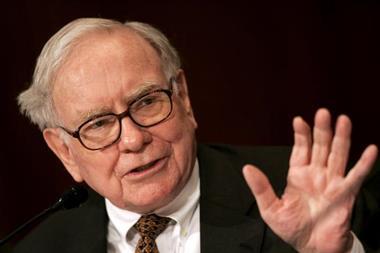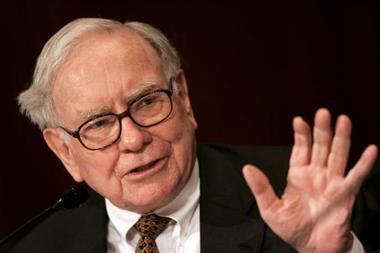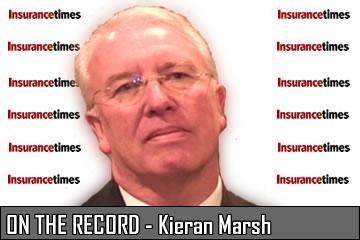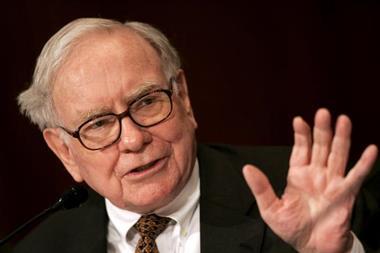The world’s richest man is also its most successful underwriter – and a canny investor who predicted the credit crisis seven years ago. Katie Puckett explores the life of the ‘oracle of Omaha’. Illustration by Richard Phipps
If you’re trying to figure out how to beat the recession this year, you could do worse than listen to Warren Buffett, the world’s most successful investor and its richest man with a personal fortune of $62bn (£40bn).
Now 78, Buffett has amassed his wealth through a lifetime of shrewd investments via his company Berkshire Hathaway, of which he is chairman and chief executive. Insurance is the core of Berkshire Hathaway – in the UK, he owns Equitas, the Lloyd’s run-off vehicle, and 20% of Swiss Re’s property and casualty business – so you could describe Buffett as the most successful underwriter in the world.
Known as the “oracle of Omaha”, his annual letters to shareholders on the principles of investing are widely read. In last year’s letter, he said of the developing subprime crash: “As house prices fall, a huge amount of financial folly is being exposed. You only learn who has been swimming naked when the tide goes out – and what we are witnessing at some of our largest financial institutions is an ugly sight.”
Buffett predicted the credit crisis much earlier, however. In 2002 he described derivatives as “toxic”, “timebombs” and “financial weapons of mass destruction”. He also appeared to foresee 9/11. Months before the attacks on New York, he advised his reinsurance businesses not to underwrite property or clients that might be unduly exposed to terrorist strikes, citing the World Trade Center as an example.
Berkshire Hathaway is not immune to the financial crisis – its shares fell 32% last year, the worst performance for three decades – but it still beat the S&P500 index, which dropped 38%.
Wall Street analysts speak of the “Buffett premium” that boosts the price of any share he invests in. Publishers too know that plastering his name on the cover of a book will cause it to fly off the shelves. There must be high hopes, then, for The Snowball: Warren Buffett and the Business of Life, a meaty biography by Alice Schroeder, an insurance analyst who spent six years following Buffett and his family.
Buffett learnt his trademark “value investing” strategy under Benjamin Graham at Columbia University in New York. Graham trained him to look at the intrinsic value of a business, to hunt out stocks that were trading far below the worth of their assets, and to hold on to them. As chairman of Geico, or Government Employees Insurance Company, Graham was also indirectly responsible for kindling Buffett’s interest in insurance.
Curious about his mentor’s investment, one Saturday morning in 1951, Buffett travelled to Washington DC and turned up at the company’s offices. He persuaded a cleaner to let him in and spent four hours quizzing the company’s vice-president, Lorimer Davidson. By the end of that conversation, Buffett was hooked. Within 48 hours he had dumped three quarters of his burgeoning stock portfolio and bought 350 shares of Geico, flying in the face of expert advice and Graham’s own opinion of the company.
Although Buffett sold his initial Geico stake in 1952, when he discovered Western Insurance, a stock that was trading at a tenth of the value of the company’s assets, he never stopped following its fortunes. By 1976, Geico had expanded its customer base beyond government employees, was far under-reserved and made a massive underwriting loss. Its stock plummeted to $2 a share. Attracted by the price and the energetic new chief executive, he bought $4m worth. The Buffett effect soon kicked in – reinsurers flocked to shore up the company and its stock price quadrupled within a few weeks.
When he started buying Berkshire Hathaway’s stock for $7.50 in 1962 it was a small textile business. Over the years, Buffett built it up into a vast holding company covering sweets, clothes, newspapers, gas and electricity, jewellery, mobile homes and private jets, with insurance at its core. At the end of 2007, it became the first US company to trade at above $100,000 a share. As well as Geico, he owns General Re, Berkshire Re and National Indemnity.
Insurance companies have been his undoing on several occasions, however. In the early 1970s, Buffett bought a small home and car insurer that, as Schroeder describes it, “promptly skidded into a ditch until a new manager towed it out”.
He spent $22bn on General Re in 1999, his largest single investment, on the basis of its genteel reputation. Days later, its chief executive Ron Ferguson called to say the company had been defrauded out of $275m. Then Buffett found out General Re had guaranteed ticket sales on Hollywood films without knowing who would star in them or reading the scripts, and Ferguson admitted it had lost another $273m from bad pricing.
Two years later, Buffett found General Re had $1.7bn worth of exposure after the 9/11 attacks – despite his warning earlier in 2001. Livid, he posted a “scarlet letter” on the company’s website lambasting its management for breaking the “basic rules of underwriting”: only accept risks that can be properly evaluated, limit your business so as not to aggregate losses from a single event or related events and avoid business involving moral risk, no matter what the rate.
By 2002, General Re had lost a total of $8bn and Buffett was so angry he could barely discuss it.
He gave part of its new business to his other reinsurer, Berkshire Re, and started funding its competitors to hedge his bets.
The company returned to profit in 2006, but that wasn’t the end of its troubles. In 2005, General Re’s management had been accused of conspiring with its customer AIG to aid and abet an accounting fraud. Last year, four former executives including Ferguson were convicted of conspiracy, securities fraud, mail fraud and making false statements to the US Securities and Exchange Commission. In December, Ferguson was sentenced to two years in jail. Buffett was cleared of all involvement.
Cynics have suggested luck has as much to do with his success as judgment, but you don’t make $62bn by accident. Buffett started young. He filed his first tax return at the age of 13, declaring his earnings from his paper round and claiming his bike and wristwatch as business expenses. In high school, he earned more than his teachers by selling used golf balls, distributing papers and installing pinball machines in local barbershops. By the time he graduated, he had hoarded $5,000 – the equivalent of $53,000.
Despite his fortune – he was a millionaire by the time he was 32 – Buffett is frugal. His salary as chief executive of Berkshire Hathaway is $100,000 with no stock options. He still lives in the five-bedroom Omaha house he bought in 1957 for $31,500 and his favourite restaurant is his local steakhouse. His one indulgence is a private jet – which he characteristically calls the Indefensible.
His three children will receive only a small part of his vast wealth; the rest is being donated to the charitable foundation set up by Bill Gates, his friend and the man he replaced at the top of the Forbes list of billionaires.
As for his predictions for insurance, Buffett was gloomy in his last shareholder letter. “That party is over,” he said. “It’s a certainty that insurance industry profit margins, including ours, will fall significantly in 2008. Prices are down, and exposures inexorably rise. Even if the US has its third catastrophe-light year, profit margins will probably shrink by four percentage points or so.
If the winds roar or the earth trembles, results could be far worse. So be prepared for lower insurance earnings during the next few years.”
Given that the winds did roar – and the markets trembled too – the oracle’s shareholder letter next month will be eagerly anticipated.
Hosted by comedian and actor Tom Allen, 34 Gold, 23 Silver and 22 Bronze awards were handed out across an amazing 34 categories recognising brilliance and innovation right across the breadth of UK general insurance.












































No comments yet